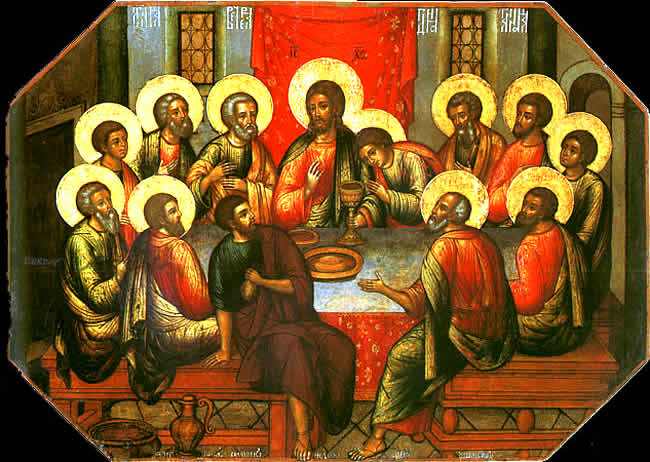This resource is out of date. Please see our latest resource here.
Today I am focusing on Maundy Thursday, the day before Good Friday, which commemorates Jesus’ last Supper with the disciples and the institution of the Eucharist. Its name of “Maundy” comes from the Latin word mandatum, meaning “command.”This stems from Christ’s words in John 13:34, “A new commandment I give unto you. Love one another as I have loved you”. Many of us associate it with foot washing:
a rite performed by Christ upon his disciples to prepare them for the priesthood and the marriage banquet they will offer, and which is rooted in the Old Testament practice of foot-washing in preparation for the marital embrace (II Kings 11:8-11, Canticles 5:3) and in the ritual ablutions performed by the High Priest of the Old Covenant (contrast Leviticus 16:23-24 with John 13:3-5). The priest girds himself with a cloth and washes the feet of 12 men he’s chosen to represent the Apostles for the ceremony. Read more
It is the oldest of the observances peculiar to Holy Week but seems to have attracted the least attention and I must confess creative suggestions were hard to come by.
Foot washing has taken on new significance for me in recent years as I reread two posts that have been contributed to my blog. Some of you might like to revisit these too.
The Dirty Job of Special Needs Parenting by Barbara Dittrich
Living Into the banquet Feast of God
I also love this post Replacing Holy Week – Towards a Public + Local Liturgy by Brandon Rhodes.
Or check out the Maundy Thursday resources at re:Worship and those at Textweek.com
Or plan a celebration based on these excellent suggestions from UCC.
I have adapted other customs of Maundy Thursday here that you may like to consider for your own observances:
- Consider a Passover meal like this Christian Seder celebration and this one detailed by Ann Voskamp
- In Germany, Maundy Thursday is known as “Green Thursday” (Grundonnerstag), and the traditional foods are green vegetables and green salad, especially a spinach salad. Consider planning a vegetarian Last Supper banquet for your celebrations and highlight the environmental issues you are concerned about.
- Visit a local homeless camp or home for the elderly (make sure you get permission first) and do foot washing and pedicures for the inhabitants.
- This is the traditional night for an all night vigil of prayer and meditation. Give yours a new twist by holding an all night reading of Dante’s Inferno as St Philips in the Hills Episcopal Church has done for the last 5 years.
- This is a day to reach out and help someone in a special way: consider looking after a child so that the mother could have a free evening, undertaking some mending or darning, humble, unostentatious things like that.
- Visit 3 or 7 local churches or other places of worship after (or before) your own service.
- In Mark Pierson’s Lenten devotional for 2013, he comments: Jesus, a king who acted like a slave. Perhaps on Maundy Thursday you would like to consider a special way to reach out to those who are still in slavery.
- One symbol of Easter I grew up with that is not so common in the U.S. is hot crossed buns wich some think originated from a 12th-century English monk who placed the sign of the cross on the buns in honor of Good Friday. So if you want to have your hot crossed buns ready for Good Friday make them on Maundy Thursday, together with your family or community. Here is the recipe I use.
For those celebrating with kids I rather liked this Fill Your Seder Plate game.
So consider including this day in your Holy Week celebrations and if you do something creative let me know.
This is part of this series on Resources for Holy Week. Here are all the posts:
Resources for Maundy Thursday:
Resources for Celebrating Holy Week With Kids:

